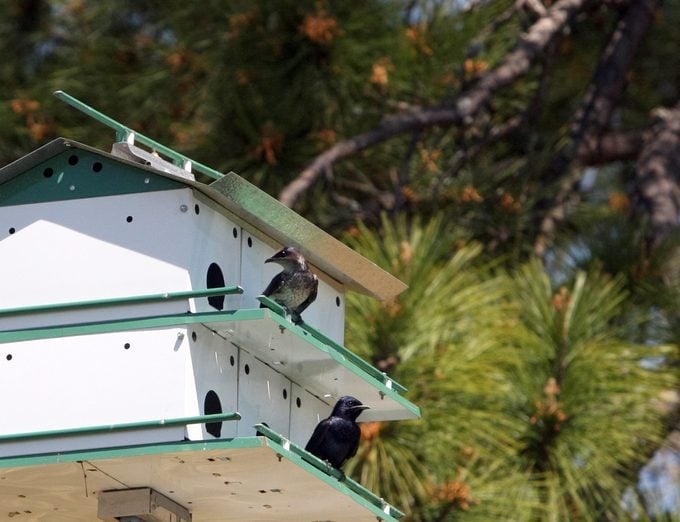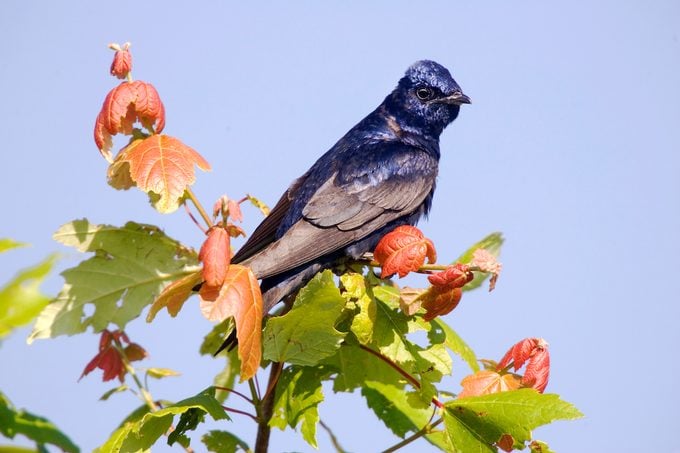Be a Good Bird Landlord With a Purple Martin House
Updated: Feb. 06, 2024
Purple-hued swallows arrive just in time to select a home for spring nesting season. Use a purple martin house to attract these birds.
On This Page
Why Purple Martins Need Birdhouses

Historically, purple martins nested in natural tree hollows, old woodpecker holes, and cliff crevices near water throughout most of the U.S. The birds continue to do so in the West, especially in saguaro cacti. But in the eastern half of the country, purple martins now nest almost exclusively in manmade boxes. Native Americans began the tradition thousands of years ago when they found that a hollow gourd placed in a tree was attractive to breeding bird pairs. Man-made purple martin houses are now essential to martins’ survival.
An estimated 1 million purple martin landlords listen each spring for the chortling call of their summer tenants reappearing from the south. Martins can often be heard calling as they glide above forested areas in an attempt to attract younger adults to the colony. In summer, purple martin houses across the country are filled with adults ready to raise their young.
Learn to identify 8 types of swallows.
How to Choose a Purple Martin House
“I’m new to attracting purple martins. Can you give me some guidance on choosing and setting up a birdhouse?” asks Birds & Blooms reader Cindy Phelps of Louisburg, North Carolina.
Birding experts Kenn and Kimberly write, “The abundance of choices for purple martins can be daunting. To get started, we recommend a house made of aluminum (painted white to reflect heat) or very thick white plastic, with at least 12 compartments. Wooden houses work, but they’re heavy, which is a drawback as the house should be mounted 12 to 18 feet above the ground. You need to be able to open each compartment individually for cleaning. For mounting, it’s best to have a sturdy pole with a pulley system so that the house can be easily raised and lowered.”
Each individual apartment should measure at least 6 x 6 x 6 inches. The entrance hole should measure 2 1/8 inches. The Purple Martin Conservation Association offers a wealth of information on attracting these birds.
Here’s how to grow birdhouse gourds and make a DIY purple martin gourd house.
Where to Place a Purple Martin House
Purple martins are colony nesters, which means they nest in groups. Whether you choose gourds or an apartment-style model, place your purple martin houses in an open area that is 40 to 60 feet away from trees and at least 12 to 18 feet above the ground. Purple martins are one of the only birds that will tolerate swaying birdhouses.
“We put up a purple martin house last year, but had no takers. Is there anything we can do to help martins find it?” asks reader Judy Roberts of Graytown, Ohio.
Kenn and Kimberly say, “Purple martins are choosy, and attracting them to a new house can take time. Make sure the house is in an open area, not hemmed in by trees. Keep the entrance holes sealed during winter so house sparrows and starlings won’t move in. Open them only around the time when the martins are expected to return in spring. Keep the house up through late summer, even if it hasn’t attracted tenants yet. Young martins look in late summer to find sites for the next year.”
Discover fascinating barn swallow facts.
Be a Good Purple Martin Landlord

Just like monitoring bluebird houses, being a purple martin landlord takes time and commitment. In summer, boxes must be kept free of non-native house sparrows. In late fall, boxes must be cleaned and closed. But it’s all worth the effort. Hosting purple martins means you’ll get to enjoy these feathered good neighbors during spring and summer before they fly the coop in fall.
Do purple martins eat mosquitoes? Here’s what you should know.
Inside a purple martin house, the nest is a cup of grass, leaves, twigs, miscellaneous debris and usually some mud. Learn more about swallows nests and nesting habits.
“Purple martin houses are a hub of activity. It’s fascinating to watch purple martins come and go. I love to watch for the youngsters poking their heads out of the boxes,” says naturalist and nature writer Ken Keffer.
Next, learn how to identify and attract a tree swallow.
Why Trust Us
For nearly 30 years, Birds & Blooms, a Trusted Media Brand, has been inspiring readers to have a lifelong love of birding, gardening and nature. We are the #1 bird and garden magazine in North America and a trusted online resource for over 15 million outdoor enthusiasts annually. Our library of thousands of informative articles and how-tos has been written by trusted journalists and fact-checked by bird and garden experts for accuracy. In addition to our staff of experienced gardeners and bird-watchers, we hire individuals who have years of education and hands-on experience with birding, bird feeding, gardening, butterflies, bugs and more. Learn more about Birds & Blooms, our field editor program, and our submission guidelines.
Sources
- purplemartin.org, the website of the Purple Martin Conservation Association
- Kenn and Kimberly Kaufman, official birding experts for Birds & Blooms
- Ken Keffer, naturalist and author




















